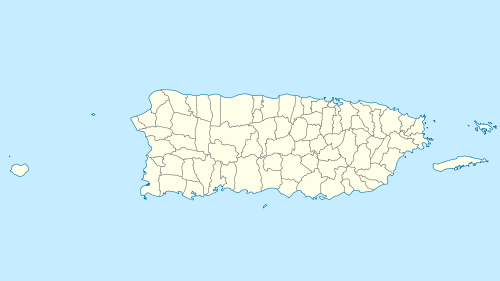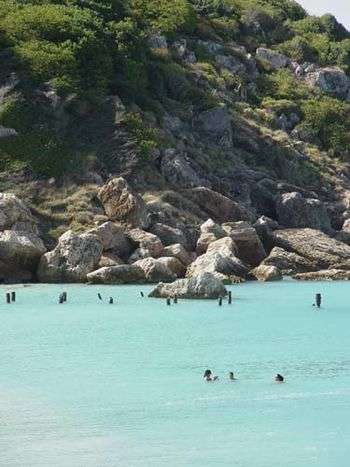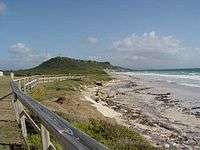Caja de Muertos
Coordinates: 17°53′41″N 66°31′8″W / 17.89472°N 66.51889°W
.jpg) Isla Caja de Muertos, Ponce Puerto Rico, looking Southeast from Puerto Rico's mainland southern shore | |
 Caja de Muertos Caja de Muertos, Puerto Rico | |
| Geography | |
|---|---|
| Location | Ponce, Puerto Rico |
| Coordinates | 17°53′41″N 66°31′8″W / 17.89472°N 66.51889°W |
| Area | 1.54 km2 (0.59 sq mi) |
| Length | 2.75 km (1.709 mi) |
| Width | 0.86 km (0.534 mi) |
| Highest elevation | 52 m (171 ft) |
| Administration | |
|
United States | |
| Commonwealth | Puerto Rico |
| Municipality | Ponce |
| Demographics | |
| Population | 0 |
| Pop. density | 0 /km2 (0 /sq mi) |
| Part of a series on |
| Tourism in Puerto Rico |
|---|
| Tourism Regions |
|
| Beaches |
| Caves |
| Cays and islets |
| Convention centers |
| Culture |
| Islands |
Caja de Muertos (English: Coffin Island or Dead Man's Chest) is an uninhabited island off the southern coast of Puerto Rico, in the municipality of Ponce. The island is protected by the Reserva Natural Caja de Muertos natural reserve, because of its native turtle traffic. Hikers and beachgoers are often seen in the island, which can be reached by ferry from the La Guancha Boardwalk sector of Ponce Playa. Together with Cardona, Ratones, Morrillito, Isla del Frio, Gatas, and Isla de Jueyes, Caja de Muertos is one of seven islands ascribed to the municipality of Ponce.[1][2]
History
In 1599, several English merchants departed to China with a letter from Queen Elizabeth to the Chinese government.[3] However, the expedition was dangerous and a ship was lost to the weather.[4] Off the Indian coast the group turned to piracy and after learning of a Portuguese ship filled with gold, silver, precious stones, other treasures and other valuables (spices, silk, some clothing), they attacked and captured the vessel.[4] The fleet managed to capture another vessel, but in the process lost its flagship and a large part of the crew was fatally injured, including the fleet commander.[4] Shorthanded, the group decided to return to England aboard a smaller ship, taking part of the loot with them.[4] After surviving an attempted mutiny, the Englishmen decided to take a canoe left behind by a frigate off Puerto Rico's eastern coast from where they took refuge at Caja de Muertos.[4] Losing the smaller vessel, the Englishmen traveled to the main island in search of provisions, but one of them left behind to mind the canoe was captured and let the presence of the treasure known to the local authorities.[5]
This led to an incursion to take the treasure, where all but one of the Englishmen were suddenly executed despite negotiations and the Spanish took the treasure with them and reported it as being captured in a battle with the English.[5] The lone survivor, named Thomas, managed to build a makeshift boat out of wood remnants and drifted to Puerto Rico, being taken to San Germán and telling his version of the events.[6] The governor of Puerto Rico grew suspicious and an investigation was held between the autumn of 1599 and early 1600, which lead to a confession by one of the murderers.[6] The authorities then began confiscating the treasure seized during the incursion, with other parts disappearing and reportedly ending in the hands of the governor's own nephew.[7] The treasure confiscated was auctioned, with about 4,000 ducats of Indian silver remaining by 1602.[7] The following governor employed another part in construction, with a collection of jewels and bars that were left behind being sold.[7] The last piece, a large gemstone, was sent abroad for transport to Spain.[8] From these events, the island would gain the moniker of "Isla de Caja de Muertos" ("Dead Man Island").[5]
Location
Caja de Muertos is located 5.2 mi (8.4 km) south of the Puerto Rican mainland and is part of the Playa[9][10] barrio of Ponce, Puerto Rico, municipality.
Geography and climate
The island measures 2 mi (3 km) long northeast-southwest, and up to 2,822 ft (860 m) wide [1,837 ft (560 m) on the average]. It has an area of 0.59 sq mi (1.53 km2). Close by are Morrillito Key [591 ft (180 m) off the southwest point, 0.02 sq mi (0.05 km2)] and Berbería Key [3.9 mi (6.3 km) to the northeast, 0.12 sq mi (0.31 km2)], both part of the Caja de Muertos Natural Reserve. Berbería Key belongs to Rio Canas Abajo barrio of Juana Diaz municipality.
The climate is dry and the island supports dry forest. A still-functioning lighthouse, Caja de Muertos Light, established in 1887 and automated in 1945, sits atop the highest hill on the island. This 170 foot high hill is located at the southwest extreme of the island.[11]
Features
The island has four beaches: Pelicano, Playa Larga, Carrucho, and Coast Guard. The island also possesses fauna and flora not found anywhere else in the world.[12] The island has no permanent residents, but the Government of Puerto Rico maintains Department of Natural Resources staff and security personnel there. In 1899, it registered a permanent population of 64 residents, but it since declined to zero.[13]
Name

Though there is no consensus on how the island got its name, one story given by Kurt Pitzer and Tara Stevens is that of a Portuguese pirate, Jose Almeida.[14] A former merchant sailor, Almeida fell in love with a Basque lady in Curaçao, married her in St. Thomas, US Virgin Islands and took her pirating with him around the Caribbean. On the first raid, she was killed by a stray bullet. Distraught, Almeida had her embalmed and placed in a glass box inside a copper coffin. He buried her in a cave in a deserted island near Ponce.[15] He would come every month to gaze over her preserved body and leave half of his treasure in her grave. Almeida, however, was caught in the Puerto Rico mainland, tried, and executed in El Morro in 1832. Many years later, a Spanish engineer discovered the glass and copper coffin, and identifying the cay on a map gave it its present name.[16] The treasure found, if any, was kept secret.[14]
Another possibility is that the island got its name because it resembles someone lying down when seen from the main island. Caja de Muertos can be translated into English as "Coffin" or "Dead Man's Chest".

In 1901, it was suggested by one A. W. Van Buren of Yale University that the island's name may be related to the sea shanty "Dead man's chest", first written by Robert Louis Stevenson for his novel Treasure Island;[17] however, no scholar since Van Buren has made this connection nor is there any evidence to support such a claim. Further, Van Buren says that Stevenson did not write the song "Dead man's chest" himself, that he "picked it up somewhere", which is another baseless claim (see "Dead man's chest" for more information on the fakelore surrounding this song).[18]
The official version of the origin of the name, as given by the Puerto Rico Department of Natural Resources, and under whose care the island is currently entrusted, is as follows: "Its name is attributed to the 18th-century French writer Jean-Baptiste Labat who called it Coffre à mort (Caja de Muertos) or Bomba d'Infierno, making reference to the fact that when the island is seen from certain places in southern Puerto Rico, it gives the impression of seeing a dead person laying on a plateau."[19]
Since 1511, the island has been called by different names including Isla Abeiranas, Abairianay, Antías, Jutías, Yautías, Utías, Abeianay, Angulo, Isla Bestia, and Isla del Tesoro, in addition to the translations as Coffre A’morr, Deadman’s Chest, and Coffin Island.[20]
Natural reserve

The island was designated as a nature reserve in 1980 after a meeting was held in Puerto Rico by the Puerto Rico Planning Board wherein they considered the recommendation set forth by the Coastal Management Zone Program to turn the island into a protected wilderness area. The island has remained a protected area ever since.[21] The protection is mainly due to its heavy turtle traffic which is an endangered species.
Beaches
The island is home to five beaches: Playa Pelícano, Playa Ensenadita ("Pocitas"), Playa Larga, Playa Blanca (also called Playa Coast Guard), and Playa Chica.[22] Playa Pelícano has been named a blue flag beach.[23][24]
- Playa Pelícano[23]
 [24] - located on the western (docking) side of the island, between the boat dock and Cerro Morrillo.[25][26]
[24] - located on the western (docking) side of the island, between the boat dock and Cerro Morrillo.[25][26] - Playa Ensenadita ("Pocitas")[22]
- Playa Larga[23] - a protected (and thus not accessible) beach on the southeastern side (the open Caribbean Sea side) of the island between Cerro Morrillo and Caja de Muertos Light.[25][26]
- Playa Blanca (Playa Coast Guard)[22][23] - located on the northwest side of the island (facing the city of Ponce), northwest of the Caja de Muertos Light.[25][26]
- Playa Chica (Playa Carrucho)[22][23] - located on the northern and northeastern end the island, facing the Puerto Rico mainland.[25][26]
See also
References
Citations
- ↑ Neysa Rodriguez Deynes. Brevario Sobre la Historia de Ponce. Second Edition. Government of the Autonomous Municipality of Ponce. 2002. Page 9. Printed by Impress Quality Printing, Bayamon, Puerto Rico.
- ↑ CityMelt. Retrieved 17 May 2011.
- ↑ Cardona 1989, pp. 204
- 1 2 3 4 5 Cardona 1989, pp. 205
- 1 2 3 Cardona 1989, pp. 207
- 1 2 Cardona 1989, pp. 208
- 1 2 3 Cardona 1989, pp. 210
- ↑ Cardona 1989, pp. 212
- ↑ General Purpose Population Data, Census 2000. Unidad de Sistemas de Información Geográfica, Área de Tecnología de Información Gubernamental, Oficina de Gerencia y Presupuesto. Gobierno de Puerto Rico. Archived 2010-08-12 at the Wayback Machine. Retrieved February 16, 2010.
- ↑ US Census. 1930 Federal Census Team Transcription. Retrieved February 22, 2010.
- ↑ Coast Pilot Nr. 5
- ↑ Por algo le llaman 'El Edén del Caribe'. Carmen Cila Rodríguez. La Perla del Sur. 20 April 2011. Retrieved 3 May 2011.
- ↑ Guillermo A. Baralt. La Historia de El Nuevo Dia (1909-2000): "Al servicio de mi tierra". Page 44. Fundación El Nuevo Dia. San Juan, Puerto Rico. 2002. ISBN 1-881720-82-9.
- 1 2 Adventure Guide to Puerto Rico. By Kurt Pitzer and Tara Stevens.
- ↑ Travel and Sports: Puerto Rico Reserva Natural Caja de Muertos.
- ↑ Lighthouse Friends
- ↑ Mail Bag Hints: Stevenson's "Dead Man's Chest." By A. W. Van Buren. The New York Times, June 29, 1901.
- ↑ Vincent Starrett. Buried Caesars: Essays in Literary Appreciation, 1923. Page 189-204.
- ↑
- nouveau voyage aux isles Tome II available at Gallica
- ↑ Caja de Muerto: mil tesoros y leyendas. Héctor Sánchez. La Perla del Sur. Ponce, Puerto Rico. 6 June 2012. Year 30, Number 1488. Page 36. Retrieved 6 June 2012.
- ↑ Puerto Rico.com: The Puerto Rico Channel. Visiting Caja de Muertos Island Nature Reserve.
- 1 2 3 4 Caja de Muertos: Un tesoro en las aguas del Mar Caribe. Mydalis M. Lugo Marrero. Revista Marejada. 3 December 2011. Retrieved 20 October 2013.
- 1 2 3 4 5 Periodico La Perla del Sur. El secreto paraíso del Caribe. By Carmen Cila Rodríguez. 14 October 2010. (Home > Gente > Portada Gente > El secreto paraíso del Caribe.)
- 1 2 Bandera azul para Caja de Muerto . Archived 2013-10-22 at the Wayback Machine. El Sur a la Vista. Ponce, Puerto Rico. December 1, 2010. Retrieved December 15, 2010.
- 1 2 3 4 RESERVA NATURAL ISLA CAJA DE MUERTOS: LABORATORIO NATURAL PARA FOMENTAR EL ESTUDIO DE AVES DENTRO DEL ESCUTISMO. Archived 2013-10-20 at the Wayback Machine. Javier González Delgado. Universidad Metropolitana, Escuela Graduada de Asuntos Ambientales. San Juan, PR. 7 Diciembre 2010. Retrieved 20 October 2013.
- 1 2 3 4 Topographic Map of Caja de Muertos, showing roads and hiking trails Archived 2015-02-19 at the Wayback Machine. "Topografico Playa de Ponce (N1752.5 W6630/7.5)." Drawn by J. A. Dones. Oficina de Planificacion de Recursos Costaneros. Departamento de Recursos Naturales y Ambientales de Puerto Rico. 1962. Retrieved 20 October 2013.
Bibliography
- Cardona Bonet, Walter (1989). Shipwrecks in Puerto Rico's History. San Juan, Puerto Rico: Institute of Puerto Rican Culture, World Archeological Research, Inc. ISBN 9780000003966.
External links
- Natural Reserve, official page
- Topographic Map of Caja de Muertos, showing roads and hiking trails "Topografico Playa de Ponce (N1752.5 W6630/7.5)." Drawn by J. A. Dones. Oficina de Planificacion de Recursos Costaneros. Departamento de Recursos Naturales y Ambientales de Puerto Rico. 1962.
- Welcome to Puerto Rico! Caja de Muertos